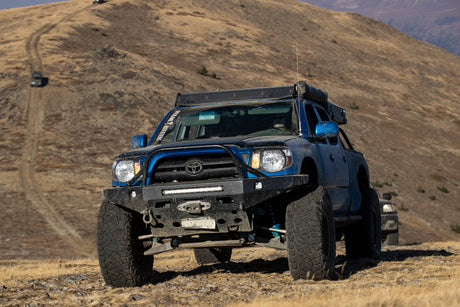Independent Front Suspension is the most common kind of suspension that we see coming through our shop. We are Toyota specialists, so we see a lot of both Tacomas and 4Runners. Having run our shop for a few years now, along with the time I've spent reading on forums online and being a part of the wheeling community, I have realized that there are a few big myths floating around regarding lifting an IFS vehicle; Especially when it comes to fitting larger tires. Although we mostly work on Toyota's, these myths apply to all A-arm style IFS vehicles.
The biggest misconception I've seen is that a suspension lift is a requisite to putting bigger tires on a vehicle with Independent Front Suspension. That is simply not the case. Excluding drop bracket lifts, a suspension lift will not give you any additional clearance for tires.
I can explain it this way; lets say your vehicle has 8” of IFS travel. At your stock ride height, you are sitting close to the middle, giving you 4” of up travel, and 4” of down travel. That's a great ride height for good suspension performance over bumpy terrain with equal parts up and down travel. Say you install a suspension lift that lifts your vehicle 2 inches. Now, out of your 8” of total travel, you have 6” of up travel, but only 2” of down travel.

Here you can see that for the same amount of wheel travel, a larger tire will not clear the wheel well when the suspension is compressed, despite clearing at ride height.
Regardless of where you sit within your 8” of travel at ride height, at full extension or full compression, your wheel will still end up in the exact same position as it would have with your stock suspension. This means that whether you are on stock suspension or a high end suspension setup, when you bottom out or turn your wheels, you will rub in all the same spots with bigger tires, regardless of how much lift you have.
With a suspension lift, you might clear bigger tires at ride height; but that is only useful if you rarely leave the pavement. We are a performance oriented “off-road” shop, so I like to assume that our customers actually use their vehicles to get off-road. If that's not you, then by all means, a lift and bigger tires will work fine on your way to the mall.
No matter what size lift you have, to properly clear bigger tires is going to require modifications. And I don't mean bolt on modifications. I mean hammering, cutting, grinding, and welding to make more space in your wheel wells to clear tires when your suspension is at full bump and your steering is at full lock. There is no way around this, whatever else you've read on the internet. It's physics baby!
I find that, for the Tacoma and 4Runner, a 33", or 285/70R17 is the best compromise for most people. They give more clearance, more off road comfort and traction, all without needing to do any major cutting in the wheel well, and without an excessive impact to on-road performance and economy. All that is usually required for proper clearance would be a mild cab mount chop, moving the pinch weld some, and a bit of plastic trimming, depending on the specific wheel/tire combo you go with.
I'm not going to talk about drop bracket lifts here, because in my opinion, they are not useful for overlanding. Although they will give you additional room for larger tires throughout the full range of travel, they will not give you better performance, and will raise your center of gravity unnecessarily high (lower is better). All while giving you no additional clearance at the belly of your truck, because all of the brackets have been extended down. In my personal opinion, it's not the best way to lift a Toyota.
This leads to the second myth that I have seen around: that lifting your vehicle equals better performance. I already touched on this a little bit earlier, but I want to elaborate a bit more. When you lift your IFS vehicle by preloading the coil more, or installing longer or stiffer coils, you are only changing your ride height. The actual wheel travel remains the same. Thus, you will have less down travel. This means that the higher you lift your front end, the more often you will feel your suspension top-out (fully extend) over holes, or after big speed bumps, etc. which can give a rough ride, especially combined with the generally stiffer coils or additional pre-load. For this reason, I recommend keeping your lift between 2-2.5".
Most of the more budget friendly lift options, such as Bilstein 5100's or Old Man Emu Nitrochargers lift your vehicle by using more preload, or a stiffer/longer coil. While they will generally perform as well as or slightly better than stock, they generally do not add any travel to your vehicle. Higher end suspension from brands like King or Fox usually have an "extended travel" option. These coilovers will allow you to lift your vehicle 3", but only lose 2" of down travel, giving much better performance (along with drastically superior strength, heat dissipation and damping). They generally will give you around 1" more travel than a non-extended coilover. These extended length coilovers do require an aftermarket upper control arm on Toyota's though, to clear the coil at full droop.

Ivan Stewart's famous race winning trophy truck was kept very low, while getting as much wheel travel out of the suspension as possible. This, combined with large tires, gives the best performance for most off-road scenarios.
So, after all of this, what do you gain by lifting your vehicle? You do gain a small amount of ground clearance in some areas, such as break-over angle. However, larger tires are the best way to gain more ground clearance. Unless you are only after the look of a lifted truck, lifting itself should not be the goal of changing the suspension on your vehicle. Performance should always be at the core of every modification, whether that's suspension, armour, lighting, or whatever else. I would prefer to set up a vehicle with less "lift" knowing that it will perform better and put less strain on stock components off-road, even if a bit more trimming or cutting is required at ride height.
What other myths have you heard about regarding IFS? Did you learn anything from this post? Did I miss anything? I’d love to hear from you in the comments below!
If you're interested in getting some suspension, or any other work done on your vehicle, get in touch with us about our installations!












10 comments
Jeep guy here. Working on a more generic document about fording deep water and have always been puzzled about lifts and IFS. Your explanation made it crystal clear. While a lift can provide a bit more room for electrical components during deep water crossings, not really something I’d recommend because of the COG impact. Thanks, much appreciated!
Love all this information! I’m new to this so this is perfect. What would you recommend for a 2nd gen 4runner? I was looking to run 33s or 35s what do you think? Thanks so much.
Lexicons mesh, puzzles tease, vocabularies bloom. Word games enrich minds, fostering fun-filled learning adventures. https://playwordgames.org
Explore the joyful world of Monkey Mart, a captivating game where you manage a bustling store, serve adorable customers, and conquer entertaining puzzles for rewards. https://quillfulgames.com/monkey-mart
Phrazle game is a fun and educational word puzzle that sharpens language abilities while providing enjoyable gaming experience. https://phrazle.website